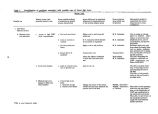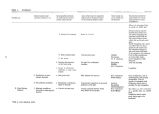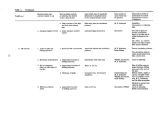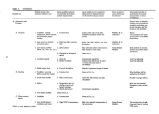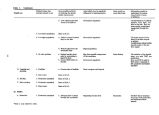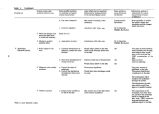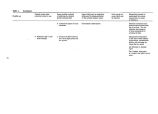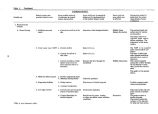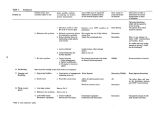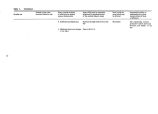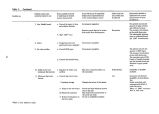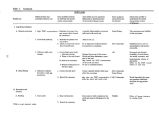| OCR Text |
Show salinity balance and stratification of the lake can be assessed. Any consequential alteration of the salinity balance would, of course, affect social uses of the lake. Breaching the causeway would alter the exchange of brine through the causeway and thus the water and salinity balances of both the north and south arms. Again, the major consideration would be whether the brines would mix or cause stratification of the north arm or further stratification of the south arm. A layer of the less saline south arm water on the surface of the north arm would have the effect of increasing evaporation rates from this water surface. The horizontal distribution of salinity in the lake is a function of the circulation patterns. No data are presently being gathered on circulation. Jones et al. ( 1976) developed a model which could predict the distribution of water quality constituents if circulation data were available. Watters and Kin- caid of Utah State University are presently involved in a project which will have the ability to predict steady state circulation patterns in the lake. Verification of their model for Great Salt Lake is dependent on the gathering of data on general circulation patterns, point measurements of velocity with depth, brine temperatures, and any fluctuations of the interface between the south arm brines. Work on understanding the mechanisms which produce the present circulation patterns should lead to an ability to predict how the circulation would be changed by the construction of additional dikes and causeways in the lake. The ionic makeup of the lake brines is being studied by the UGMS. The UGMS brine sampling program provides a record of the ionic makeup of both arms of the lake. Jurinak of Utah State University has developed a model which is capable of predicting the ionic makeup of the north arm at various lake levels. He is working on including heavy metals into the model. His goal is to develop a general model applicable to the entire lake. Bio tic System The total number of species which inhabit the waters of Great Salt Lake is limited due to the harsh environment created by the high brine concentration. Organisms found in the lake include bacteria, green and blue- green algae, diatoms, protozoa, corixid, brine shrimp, and brine flies. In addition, forms typical of fresh water are found in the lake on occasion, but it is believed that these are extraneous forms which have been carried in with freshwater and probably survive only short periods of time. An excellent discussion of the present knowledge on life form in and around the lake is found in Rawley et al. ( 1974). Much of the biological work on the lake was done in the 1930s. Flowers ( 1934) found four species of blue- green algae and two species of green algae. Kirkpatrick ( 1934) cultured lake waters in the laboratory in an attempt to separate native from extraneous algae forms. She reported 13 species of aigae as well as some protozoa. Patrick ( 1936) identified 24 genera and 62 species of diatoms from lake bottom samples. Eardley ( 1938) reviewed the literature on life in the lak^ and listed the brine shrimp, three flies, five protozoa and 13 species of algae. ZoBell et al. ( 1937) worked on the bacterial flora of the lake. This type of work performed prior to the construction of the railroad causeway probably still applies to the south arm. Stephens and Gillespie ( 1972) identified the basic components of the south arm ecosystem. They identified two energy flow sytstems with only minor interactions: A planktonic system consisting of algae, brine shrimp, and several protozoa and bacteria; and a benthic sequence consisting of the blue- green algae, detritis, and the brine fly larvae. The only outflow from either system occurs when birds feed on brine shrimp and brine flies and when adult brine flies leave the lake. The authors express concern that the toxic effect of many substances presently inflowing to the lake may reach concentrations where they effectively eliminate the flora and fauna of Great Salt Lake. Porcella and Holman ( 1972) studied the nutrients in Great Salt Lake and the influence of these nutrients on algal growth. The relation between food supply ( algae) and the growth of brine shrimp also was studied. The study results indicate the relation between inorganic nutrients, algae, and brine shrimp. They concluded that inorganic nitrogen is apparently the limiting factor for growth. Forthcoming publications by Stube, Post, and Porcella ( 1976) of Utah State University contain information on the ecosystem and nitrogen cycle of the north arm. Stube's work indicates a relatively simple ecosystem in the north arm composed of four groups; the algae, the bacteria, the brine shrimp, and the brine fly. He provides information on the biomass of each group, the interactions between groups, and the importance of organic matter and ammonia as nutrients. Research on the lake ecosystem is encouraging. The remaining research centers on quantitatively defining the interactions between organisms, organisms and the environment, the water quality- ecologic relationships, and the various factors which can disrupt the ecosystem. The growth rates of organisms and the rate of grazing of one organism on another need to be made and the effect of environmental factors 44 |


















